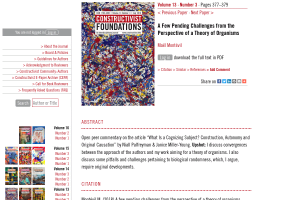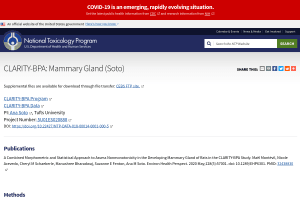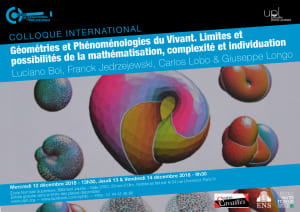
Archives of 2018 in english
-

-
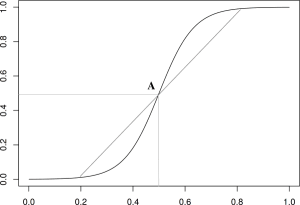
A primer on mathematical modeling in the study of organisms and their parts
Systems biology
How do mathematical models convey meaning? What is required to build a model? An introduction for biologists and philosophers.
Abstract
Mathematical modeling is a very powerful tool for understanding natural phenomena. Such a tool carries its own assumptions and should always be used critically. In this chapter, we highlight the key ingredients and steps of modeling and focus on their biological interpretation. In particular, we discuss the role of theoretical principles in writing models. We also highlight the meaning and interpretation of equations. The main aim of this chapter is to facilitate the interaction between biologists and mathematical modelers. We focus on the case of cell proliferation and motility in the context of multicellular organisms.
Keywords: Equations, Mathematical modeling, Parameters, Proliferation, Theory
Manuscript Citation Publisher Full textCitation
Montévil, Maël. 2018. “A Primer on Mathematical Modeling in the Study of Organisms and Their Parts.” In Systems Biology, edited by Mariano Bizzarri, 41–55. Methods in Molecular Biology. New York, NY: Springer New York. https://doi.org/10.1007/978-1-4939-7456-6_4 -
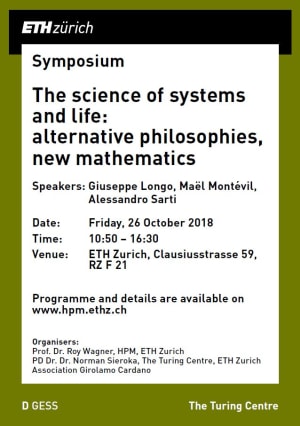
What is a new possibility in theoretical biology?
Biological evolution involves the appearance of new traits, new phenotypes and new processes but the mathematical understanding of such novelties is still lacking. In this paper, I argue that the notion of a new possibility should be and can be a fundamental notion in biology. This idea has been used in several models but it still lacks a proper mathematical, theoretical and epistemological framework. The notion of new possibility should be analyzed carefully since, like for the notion of probability, points of view a priori and a posteriori cannot be conflated. Moreover possibilities are virtual and it seems at first sight that adding possibilities by a retrospective theoretical move does not change the state of an object. In order to define precisely the notion of new possibilities, I will first discuss a positive notion of possibility which pertains to properties that are properly defined theoretically. This will lead us to a more precise discussion than the set-theoretic language to describe possibilities and enable us to define a robust notion of new possibilities.
-

Symposium: The science of systems and life: Alternative philosophies, new mathematics
We are a group of mathematicians who denounce a mathematization of the world oriented towards purely quantitative analyses and reductionism, rather than invention and construction of understanding. The prevailing use of mathematics as a search for “optimal paths” in economy, biology and general human activities supposes a pre-given universe of possibilities and is suitable for control more than for knowledge construction and a common action. Sometimes, researchers even claim that “computer programs” run organisms’ development and animal or human behavior.
We are instead interested in the historical emergence of meaning in changing spaces of possibilities as well as in the production of sense in science and in the personal activity of the researcher. Our current work focuses on historicity, organicity and contextuality of life; on the role of interpretation and meaning in the process of vision; on the importance of interpretation in the applications of mathematics and of a committed analysis of future projections in areas such as finance and ecology.
In 2017, we proposed the creation of the association Girolamo Cardano (1501- 1576: inventor of imaginary numbers, first thinker of the transformation of the living in time) that readers are invited to join: http://cardano.visions- des-sciences.eu -

The coding of life. Breakthroughs and blind spots in the mathematisation of the life sciences.
-

Secrecy, transparency and opacity in biology.
In biology, the molecular biology revolution lead to the prevalence of a linguistic metaphor in the second half of the twentieth century. This metaphor led to a double perspective on secrecy: biologists aimed to unravel the secrets of the living, which would be revealed by reading and decoding DNA, and the secrecy between researchers competing to decode the same "information". This framework is now outdated, both for the understanding of life and in social practice. Biology seems to hesitate between imposing transparency, on both its practices and its objects, and recognizing the existence of several opacities.
-

Round table: Mathematics, life sciences, finance, work and economy
Nicholas Georgescu Rœgen and René Passet, as well as MIT, have emphasized that entropy and negentropy should be central to economic analysis. We will see that this requires us to consider anti-entropy as a dynamic factor, and to specify its role in a contributive economy, according to biology.
-

Entropy and the anthropocene
-
A few pending challenges from the perspective of a theory of organisms
Constructivist Foundations
I discuss convergences between the approach of N. Palfreyman and J. Miller-Young and my work aiming for a theory of organisms, in particular on randomness.
Abstract
Open peer commentary on the article “What Is a Cognizing Subject? Construction, Autonomy and Original Causation” by Niall Palfreyman & Janice Miller-Young. http://constructivist.info/13/3/362.palfreyman Upshot: I discuss convergences between the approach of the authors and my work aiming for a theory of organisms. I also discuss some pitfalls and challenges pertaining to biological randomness, which, I argue, require original developments.
Manuscript Citation Publisher Full textCitation
Montévil, Maël. 2018. “A Few Pending Challenges from the Perspective of a Theory of Organisms.” Constructivist Foundations 13 (3): 377–79. http://constructivist.info/13/3/377.montevil -
What first principles for mathematical modeling in biology?
By analogy with theoretical physics, theoretical biology is not limited to mathematical modeling. Instead, theoretical biology should strive to find suitable first principles to ground the understanding of biological phenomena and ultimately frame biological experiments and mathematical models. First principles in physics are discussed in terms of symmetries and the associated conservation principles, on the one side, and optimization on the other side.
In biology, we have argued instead that a strong notion of variation is fundamental. This notion encompasses new possibilities and is associated with the historicity of biological phenomena [3]. By contrast, the relative regularity of some aspects of biological organisms should be seen as the consequence of a mutual stabilization by the parts of organisms [2].
In this paper, we will focus on a last aspect which pertains to the way cellular behavior is framed theoretically: should cells of multicellular organisms be considered as spontaneously quiescent so that a stimulation would be required for them to move or proliferate, or should cells be considered as spontaneously moving and proliferating so that quiescence would be the result of constraints. We argue the latter and will show that this assumption can be used to build a model of epithelial morphogenesis in tissue culture. -

Comparing symmetries in models and simulations
Springer handbook of model-based science
We distinguish mathematical modeling, computer implementations of these models and purely computational approaches by their symmetries and by randomness.
Abstract
Computer simulations brought remarkable novelties to knowledge construction. In this chapter, we first distinguish between mathematical modeling, computer implementations of these models and purely computational approaches. In all three cases, different answers are provided to the questions the observer may have concerning the processes under investigation. These differences will be highlighted by looking at the different theoretical symmetries of each frame. In the latter case, the peculiarities of agent-based or object oriented languages allow to discuss the role of phase spaces in mathematical analyses of physical versus biological dynamics. Symmetry breaking and randomness are finally correlated in the various contexts where they may be observed.
Keywords: Phase Space, Symmetry Breaking, Chaotic Dynamic, Object Oriented Programming, Genetically Modify Organism
Manuscript Citation Publisher Full textCitation
Longo, G., and Maël Montévil. 2018. “Comparing Symmetries in Models and Simulations.” In Springer Handbook of Model-Based Science, edited by M. Dorato, L. Magnani, and T. Bertolotti, 843–56. Springer International Publishing. https://doi.org/10.1007/978-3-319-30526-4 -
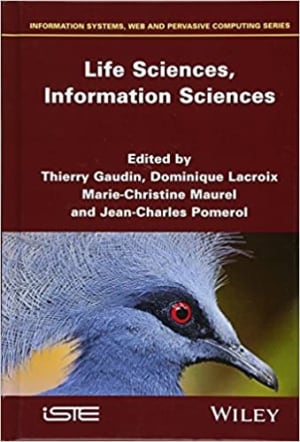
From the century of the gene to that of the organism: Introduction to new theoretical perspectives
Life sciences, information sciences
Our group proposes three main principles for a theory of organisms, namely: the default state, the principle of variation and the principle of organization.
Abstract
Summary This chapter briefly presents and describes the three main principles that the group proposes for a theory of organisms, namely: the default state, proliferation with variation and motility, the principle of variation and the principle of organization. It is crucial to critique the philosophical and theoretical position on which the biological research feeding into the program is based and which has dominated biomedical research for the last 70 years. Physical theories are founded on stable mathematical structures, based onregularities and especially on theoretical symmetries. At the time of cell theory formulation and still today, cell theory plays a federating role between evolution biology and organism biology. Finally, analysis of the differences between the physics of inanimate and living matter leads to the proposal of three principles that provide aviable perspective for the construction of a necessary theory of organisms.
Keywords: cell theory, evolution biology, mathematical structures, organism biology, philosophical position, physical theories, theoretical symmetries
Manuscript Citation Publisher Full textCitation
Montévil, Maël, Giuseppe Longo, and Ana M. Soto. 2018. “From the Century of the Gene to That of the Organism: Introduction to New Theoretical Perspectives.” In Life Sciences, Information Sciences, edited by T. Gaudin, D. Lacroix, M.‐C. Maurel, and J.‐C. Pomerol, 81–97. Information Systems, Web and Pervasive Computing Series. London: John Wiley & Sons, Ltd. https://doi.org/10.1002/9781119452713.ch9 -
NTP. CLARITY-BPA. Chemical effects in biological systems (CEBS): Mammary gland
Citation Publisher DetailsCitation
Montévil, Maël, Nicole Acevedo, Cheryl M. Schaeberle, Manushree Bharadwaj, Suzanne E. Fenton, and Ana M. Soto. 2018. “NTP. CLARITY-BPA. Chemical Effects in Biological Systems (CEBS): Mammary Gland.” Dataset. National Toxicology Program (NTP). https://doi.org/10.22427/NTP-DATA-018-00014-0001-000-5 -

Possibility spaces and the notion of novelty: From music to biology
Synthese
What is a biological novelty? Is it possible to coin a sound concept of new possibility? What articulation between the concepts of novelty and function?
Abstract
We provide a new perspective on the relation between the space of description of an object and the appearance of novelties. One of the aims of this perspective is to facilitate the interaction between mathematics and historical sciences. The definition of novelties is paradoxical: if one can define in advance the possibles, then they are not genuinely new. By analyzing the situation in set theory, we show that defining generic (i.e., shared) and specific (i.e., individual) properties of elements of a set are radically different notions. As a result, generic and specific definitions of possibilities cannot be conflated. We argue that genuinely stating possibilities requires that their meaning has to be made explicit. For example, in physics, properties playing theoretical roles are generic; then, generic reasoning is sufficient to define possibilities. By contrast, in music, we argue that specific properties matter, and generic definitions become insufficient. Then, the notion of new possibilities becomes relevant and irreducible. In biology, among other examples, the generic definition of the space of DNA sequences is insufficient to state phenotypic possibilities even if we assume complete genetic determinism. The generic properties of this space are relevant for sequencing or DNA duplication, but they are inadequate to understand phenotypes. We develop a strong concept of biological novelties which justifies the notion of new possibilities and is more robust than the notion of changing description spaces. These biological novelties are not generic outcomes from an initial situation. They are specific and this specificity is associated with biological functions, that is to say, with a specific causal structure. Thus, we think that in contrast with physics, the concept of new possibilities is necessary for biology.
Keywords: Novelty, Possibility space, Biological function, Organization, Emergence
Manuscript Citation Publisher Full textCitation
Montévil, Maël. 2018. “Possibility Spaces and the Notion of Novelty: From Music to Biology.” Synthese 196 (11): 4555–81. https://doi.org/10.1007/s11229-017-1668-5 -

Big data and biological knowledge
Predictability and the unpredictable. Life, evolution and behaviour
Can big data replace theoretical thinking? How should these technics be used? A critical discussion on the use of big data in biology.
Abstract
Some authors assert that the analysis of huge databases could replace the scientific method. On the contrary, we argue that the best way to make these new technologies bear fruits is to frame them with theories concerning the phenomena of interest. Such theories hint to the observable that should be taken into account and the mathematical structures that may link them. In biology, we argue that the community urgently needs an overarching theory of organisms that would provide a precise framework to understand lifecycles. Among other benefits, such a theory should make explicit what we can and cannot predict in principle.
Keywords: Big Data, biological variation, cancer biology, knowledge, theory
Manuscript Citation Full textCitation
Montévil, Maël, and G. Longo. 2018. “Big Data and Biological Knowledge.” In Predictability and the Unpredictable. Life, Evolution and Behaviour, edited by Giulia Frezza and David Ceccarelli, 133–44. Roma: CNR Edizioni



